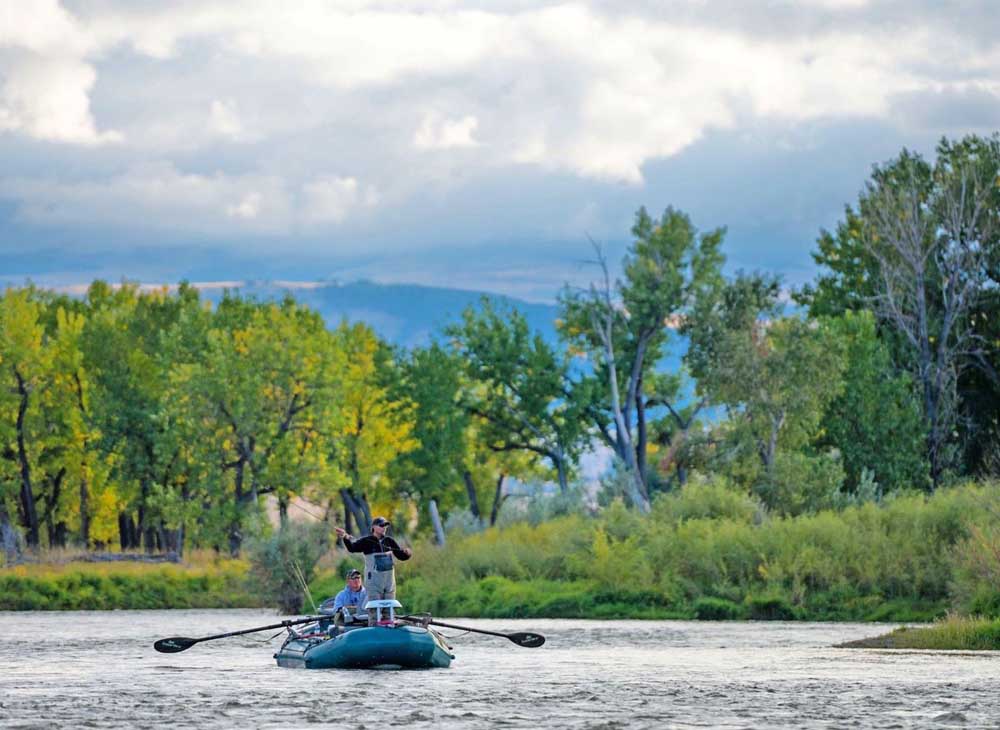Group calls for management-policy change on Montana river
Published 12:00 am Thursday, January 25, 2018

- Recent calculations from Montana Fish, Wildlife & Parks estimated resident anglers spent about $3.8 million compared to $98.4 million by nonresidents to fish the Bighorn River.(Photo by Hale Harris)
Calling one of Montana’s most famous trout fishing streams “at risk,” a coalition of Bighorn River anglers, outfitters, a ranch manager and U.S. senator are joining together in a concerted push for new water management.
Squarely in the group’s sights is the U.S. Bureau of Reclamation, which manages Yellowtail Dam. Since 1967 the dam has backed up 70 miles of the Bighorn River through a serpentine and stunningly beautiful desert canyon, all the way south into Wyoming. Below the dam, the released water and the reservoir’s entrapment of upstream sediment have created a world-renowned coldwater trout fishery.
Based on new analyses by the Bighorn River Alliance, mismanagement of the dam by the bureau has cost taxpayers millions in electricity revenue and resulted in lost income for the river’s angling and agricultural economies.
“The Bureau of Reclamation can’t keep wasting taxpayer money and hurting the local economy,” said U.S. Sen. Jon Tester, D-Mont., in a statement. “It’s time to make a change.”
A bureau official said the agency has not reviewed the alliance’s findings, although it was provided with copies.
Lost revenue
Perhaps the most stunning and unique new claim from the alliance is that, since 2008, the bureau has lost an estimated $64 million in revenue due to water spillage. The Bighorn River Alliance’s Doug Haacke calculated the figure by using the bureau’s own hydrologic monitoring system to track water releases that didn’t go through electricity-generating turbines — an estimated 4.6 million acre feet — and multiplying that amount by a current fair market value of $14 per acre foot.
Haacke’s analysis also shows how the change in management of the dam has led to that spillage. Between 1967 and 1993, spillage over Yellowtail Dam was just above 1 million acre feet, Haacke calculated. In 1994, when the Bureau of Reclamation split management of the system between Wyoming and Montana — instead of continuing to manage it as one river basin — spillage increased to 4.6 million acre feet between 1994 and 2017. The alliance has long charged that the two states aren’t effectively communicating with each other, despite the bureau’s assurances that they are in constant contact.
According to Haacke’s calculations, most of those large releases did not occur until after the 2008 management criteria change, when the bureau was attempting to keep more water in the reservoir to make Horseshoe Bend Marina, at the south end of the lake, accessible to boaters by Memorial Day.
Net economic value
The Bighorn River Alliance also calculated a new value for the river’s economy to highlight the importance of the fishery.
Using updated figures, the report places the “total economic value” of the river and its fishery to Montana’s economy at more than $134 million a year. Total economic value is not just what anglers spend but also includes the value of the existence of the river, that it will be there in the future and that some people would be willing to pay to preserve the option of someday using the river. According to a 1987 study for Montana Fish, Wildlife and Parks on the net economic value of fishing, which was cited by the alliance, only 20 percent of a resource’s total economic value is recreation.
John Duffield, an author of that 1987 study and a retired University of Montana professor, explained net economic value as those who are willing to pay for panda bear conservation even though they may never see one.
“It’s kind of philosophical, but it’s real,” he said.
The report also generated some other new figures, including a loss of $288,000 from 48 acres of cropland being washed away in high flows and $7 million in lost income to agricultural producers due to interrupted irrigation or crop planting along the river below the reservoir since new operating criteria were introduced in 2008.
Boiled down, the alliance would like to see the bureau push back its target date for filling the reservoir high enough from Memorial Day weekend to roughly two weeks to a month later.
Bureau under scrutiny
Because of the Bighorn River’s popularity, and the businesses and economy it sustains, the bureau operates under a microscope and must weigh the competing demands of Montana vs. Wyoming, river anglers vs. reservoir boaters, as well as the National Park Service’s Bighorn Canyon National Recreation Area, which surrounds the canyon, and the adjoining Crow Tribe’s reservation.
“Reclamation continues to strive to work transparently with all stakeholders to manage the multiple uses and benefits of the Yellowtail Unit,” Jordan Clayton, of the Montana office of the bureau, wrote in an email.
Working with those groups, the bureau has repeatedly adjusted its operation plans, Clayton said, including in 2010, “minor revisions” in 2012 as well as in the fall of 2015.
“There is an active effort by Reclamation to review the operating criteria for Yellowtail,” he said.
At a November meeting of the varied interests groups, Clayton said the agency announced an “independent internal review of the current criteria to determine if the original assumptions and expected outcomes are being realized, and if not, why.”
All parties will be closely watching the bureau’s review and the resulting outcome, if any, including one of Montana’s U.S. senators.
“The Bighorn River is a treasure and we need to ensure it’s properly managed for future generations of Montanans,” Tester said.






